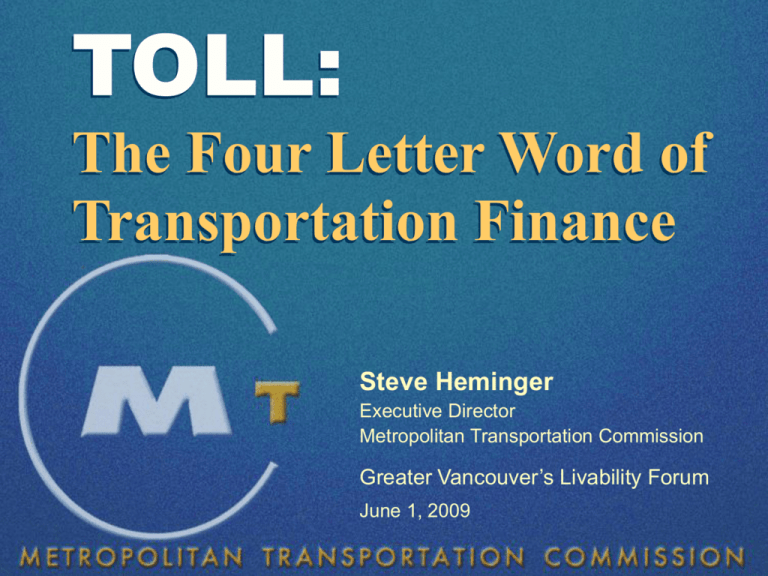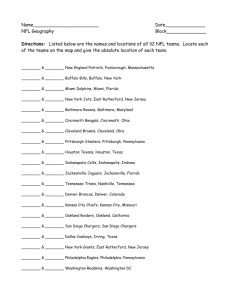
TOLL:
The Four Letter Word of
Transportation Finance
Steve Heminger
Executive Director
Metropolitan Transportation Commission
Greater Vancouver’s Livability Forum
June 1, 2009
1. BRIDGES
2
“A bridge is to
a road as
a diamond is
to a ring”
— Anonymous
3
Bay Area’s Network
The Metropolitan
Transportation Commission
(MTC) is the metropolitan
planning organization for the
San Francisco Bay Area
400 miles of carpool lanes
1,400 miles of highway
19,000 miles arterial streets
7,000 miles of transit routes
8 toll bridges
4
Back to the Future?
California Toll Bridge
Authority
Separate from the
California Division of
Highways – predecessor of
Caltrans
5
Bay Area’s Toll Bridges
The Bay Area Toll Authority (BATA)
oversees seven state-owned toll
bridges in the San Francisco Bay
Area
San Francisco-Oakland Bay
San Mateo-Hayward
Dumbarton
Richmond-San Rafael
Carquinez
Benicia-Martinez
Antioch
* Golden Gate Bridge owned and operated by the Golden Gate Bridge,
Highway and Transportation District (GGBHTD)
*
Bay Area’s Toll Bridges
Toll Bridge
Average Daily
Year Opened
Crossings
San Francisco-Oakland Bay
1936
269,000
Richmond-San Rafael
1956
71,000
Carquinez
1958/2003
129,000
Benicia-Martinez Bridge
1962/2007
103,000
San Mateo-Hayward
1967
92,000
Antioch
1978
15,000
Dumbarton
1984
61,000
Total Average Daily Crossings
740,000
7
Toll Structure and Revenues
Toll Structure
Regional Measure 1 (1989)
Seismic Surcharge (1998)
Regional Measure 2 (2004)
Seismic Surcharge (2007)
Total Auto Toll
$1
$1
$1
$1
$4
Annual Toll Revenues
Regional Measure 1 (1989)
Seismic Surcharge (1998)
Regional Measure 2 (2004)
Seismic Surcharge (2007)
Total Annual Revenues
$130 M
$120 M
$120 M
$120 M
$490 M
8
Earthquakes
1989 Loma Prieta
6.9 Magnitude
60 miles from
San Francisco
9
Toll Bridge Seismic Retrofit
Program
$8.7 Billion Retrofit
Program on the following
bridges:
San Mateo-Hayward
(2000)
Carquinez (2002)
Benicia-Martinez (2002)
Richmond-San Rafael
(2005)
San Francisco-Oakland
Bay (Under Construction)
10
Oakland Touchdown Under Construction
11
Completed Skyway
12
Steel Roadway Decks
Steel Roadway Boxes Under Fabrication
13
Tower Leg in Rotating Jig
14
1,700 Ton Shear-leg Crane Barge Undergoing Testing
15
Yerba Buena Island Detour Construction
16
Regional Measure 1 Program
$2.4 Billion Congestion Relief Program including:
San Mateo-Hayward
Bridge Widening (2003)
New Carquinez Bridge (2004)
Richmond-San Rafael Bridge
Trestle Replacement (2005)
Richmond-San Rafael Bridge
Deck Overlay (2006)
New Benicia-Martinez Bridge
(2007)
I-880/SR-92 Interchange
Reconstruction (Under Construction)
17
New Carquinez Bridge (2003)
18
Benicia-Martinez Bridge (2007)
19
Regional Measure 2
Capital Project
Program
Project
Funding
(in $ millions)
The RM2 funding program is
primarily oriented towards
transit alternatives
Ferry Programs
$197
Bus Programs
$157
Transbay Terminal
$150
RM2 provides partial funding
to projects, balance provided
by project sponsor
BART Tube Seismic
$143
Dumbarton Rail
$135
Interstate 80/680
Improvements
$100
If funding or project fails,
BATA can reallocate funding
to different project in the same
bridge corridor
E-BART Extension
$96
BART-Warm Springs
$95
Interstate 580 Corridor
$65
Caldecott Tunnel 4th bore
$51
20
Regional Measure 2
Operating Program
RM2 provides a key
source of funding for a
variety of new transit
services
Operating cost payments
are subordinated to debt
service
Project
Annual Funding Cap
(in $ millions)
Regional Express Bus (S)
7.4
Alameda Ferry
7.2
Dumbarton Rail
6.2
Regional Express Bus (N)
3.9
Albany Ferry
3.6
South SF Ferry
3.4
Vallejo Ferry
3.1
Water Transit Administration
3.0
AC Transit
3.0
Muni Metro
2.5
Golden Gate
2.4
Owl Bus
2.1
Napa Transit
0.4
21
BATA’s Debt Portfolio
Current BATA debt portfolio is $5.1 billion
$2.9 billion fixed rate debt
$2.2 billion variable rate debt
The weighted cost of the entire “AA” portfolio is $ 4.20%,
as of March 2009
Principal
Debt
(in $ millions)
Percent
Fixed
2,900
57%
Variable
2,200
43%
Total Debt
5,100
100%
22
2. HOT
NETWORK
23
“Why do you
rob banks?
That’s where
the money is.”
— Attributed to Willie Sutton
24
What are HOT Lanes?
High-Occupancy Toll
Lanes, or Express Lanes
HOV lanes with a twist
Carpools, buses free
Single drivers can choose
to pay (congestion
insurance)
Electronic tolls
Variable tolls to manage
demand
25
HOT Lanes Across the U.S.
• Orange County (1995)
• San Diego (1998)
• Houston (1998)
•
•
•
•
Minneapolis (2005)
Denver (2006)
Seattle (2008)
San Diego extension (2008)
•
•
•
•
•
Miami (2008)
Houston expansion (2009)
Los Angeles (2010)
Bay Area I-680, I-580 (2010)
Bay Area Rte 85/U.S. 101
(2013)
• Riverside (2015)
26
Proven Corridor
Management Tool
Fewer Delays Reported
(Minneapolis) 20%
Reduced crashes
(Minneapolis) 12%
Improved Travel Speeds
(Minneapolis) 5%
Increased Carpooling
(San Diego) 58%
Doubled Vehicle Throughput
(Orange County) 100%
-40%
-20%
0%
20%
40%
60%
80%
100%
120%
27
Bay Area
HOT Network
800 miles total
500 miles conversion (63%)
400 existing
100 fully funded
300 miles of new lanes (37%)
60% are “gap closures”
5% increase in freeway
mileage
28
28
What will it cost and how
much revenue will be
generated?
HOT network revenues were based on planning level
financial estimates
Costs assume Rapid Delivery model
2009 through 2033, escalated
Gross revenue
$13.7 B
Capital cost
$3.7 B
Financing cost
$1.9 B
O&M cost
$2.0 B
Net Revenue
$6.1 B
29
3. CONGESTION
PRICING
30
But…
HOT lanes are popular because motorists can
choose to use them – or choose not to
That choice also limits the effectiveness of
HOT lanes as a congestion relief strategy
for most motorists
31
European/Asian Model:
Cordon/Area Pricing
Stockholm
London
Singapore
32
Cordon Pricing in the U.S.?
New York?
San Francisco?
33
Peak Pricing Common in Many
North American Industries
Telephone
Charges
Hotel Rates
Air Fares
Movie
Tickets
34
… But Not in the
Transportation Sector
35
Why is paying more
(higher tolls) for a scarce
commodity (road capacity)
such a hard sell
(in transportation)?
36
Are There Technology
Obstacles?
37
© 2006 John O’Brien from cartoonbank.com. All Rights Reserved.
Not Anymore
Toll collection lanes with electronic toll collection capability
Source: FHWA
38
Is the Public Opposed?
39
Not if You Ask Them
1995 Bay Area Poll: $3 peak toll
2000 Bay Crossings Study:
$4 peak toll
3% no opinion
Percent Support
80%
Support for Congestion Pricing
60%
40%
20%
0%
40
Is Pricing Fair to the Poor?
The answer depends
on two things:
1) Who pays the higher toll
2) How the revenue is spent
41
Who Pays
Household Income:
Average Household vs. Bay Bridge Peak Commuters
42
Robin Hood Spending
Travel alternatives –
transit, carpooling,
vanpooling
Off-peak discounts – lower
tolls in non-commute hours
Lifeline toll – similar to public
utility programs for
low-income customers
43
Traffic Congestion = Evil #1
Congestion Pricing = Evil #2
44
“ When faced with a
choice between two
evils, I always
choose the one I
haven’t tried before”
— Mae West
45
www.mtc.ca.gov
46





